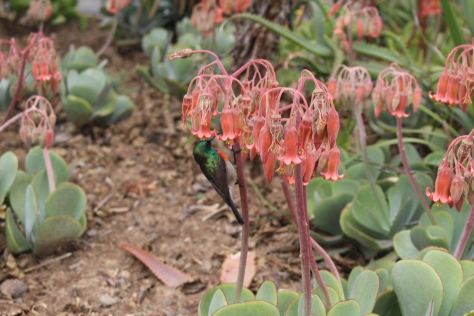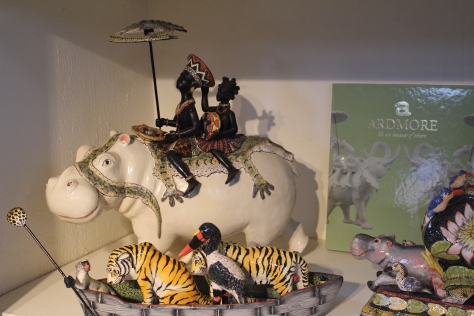It was a little sad to leave the game reserve after two days, but Greg had much more that he wanted us to experience. So we headed inland toward the “battlegrounds” area. After a long drive…
…we spent the night in a 100+ year old inn, with a nice bar and a good dinner and a delightful owner.
In the morning we drove to Rorke’s Drift. A “drift” is a place to ford a river, and Jim Rorke was a trader who had become an institution at this crossroads. I will attempt a little historical background before telling the story…
The British didn’t care a whole lot about southern Africa back in the 1800’s, except they wanted Cape Town as a stop-over for ships bound to/from India. They attacked the Dutch and took Cape Town by force, then later suffered some compunction and gave it back. And then they purchased it from the Dutch!
But around 1860 diamonds were discovered in the area, and suddenly Britain wanted to control South Africa. They suppressed most local tribes, but as you will recall from our previous history lesson, King Shaka had built an extremely powerful Zulu army. And so begins the Anglo-Zulu War in 1879.
The Brits marched toward the Zulu capital, didn’t get very far, and set up camp atop a large hill called Isandlwana, not far from Rorke’s place. An overly arrogant Lord Chelmsford believed the hill could be easily defended from the savages… Those “savages” then fooled a reconnaissance team into thinking that the Zulu force was to the SE, and Chelmsford marched half of his 3,000 men off in that direction. The Zulus then attacked from the NE. Of the 1750 men in camp, 1350 were killed. (Many of the rest ran.) It was such a crushing defeat of the all-powerful British forces, that many Brits went into denial about it, and made up various excuses and laid blame on officers that had been killed.
Just a few hours later, Zulus attacked what had been a Swedish mission, now a Brit military hospital, at Rorke’s Drift. There were only 139 men there, many of them sick or injured. The Zulu leader was apparently angry that his group had missed the action at Isandlwana, and he led his men in a direct assault of the hospital. In an ironic mirror-image of Lord Chelmsford’s misjudgment at Isandlwana, the Zulu leader did not follow the usual Zulu “horns of the buffalo” attack strategy, or any strategy other than go head on at the point where the defense was strongest. As a result a huge number of attackers were killed, and the small group of defenders held out until help arrived.
From the Zulu point of view what happened at Rorke’s Drift was of little consequence. But the Brits played it up as big as possible, to steer attention away from their debacle a few miles away.
Of course the Brits eventually prevailed in the war (only to then fight the Anglo-Boer War some years later).

Lots more driving, from the Battlefields area to the Midlands, and a night at a wonderful manor that seemed to belong in the heart of England.





A day doing nothing at Rawdon’s sounded appealing, but we had places to go. Next stop: the site where Nelson Mandela was captured (and then imprisoned for 27 years). Mandela himself wanted no memorial of significance at the spot, but more recently an evocative sculpture was done and a museum built. The museum is fascinating, telling the story of the man and the fight against apartheid.
Many students were there on field trips, which was nice to see. Many of them wanted their picture taken. A little like Indonesia but without the “Hey Mister!”
But the highlight was the walk to the sculpture. From a distance it is a bunch of funny-looking metal posts, but they morph as you approach…
And then more driving into the Drakensberg Mountains. It was misty/cloudy in the afternoon when we arrived, but wow…air so clean…silence so deep…the place had a wonderful and spiritual feeling. This area used to be home to the Bushmen, aka San People. There are rock paintings done by them, some 5000 years old, some from 150 years ago.









In the high distant mountains is the completely-surrounded-by-South-Africa country of Lesotho. When King Shaka vanquished his enemies and forced them to join his ranks, some chose instead to flee to the mountain tops. There they developed their own culture, and now their own high-altitude country.


And then we headed “home.” But we made a stop at the Ardmore ceramics center. Here Zulus are trained in techniques, but then they are free to make their own creations. Ardmore works have become world-renowned. They say they have no problem finding capable artists, but they have lost many to the AIDS epidemic. Those fallen artists are commemorated on a wall of ceramic works showing their faces. A happy sign is that none of the current artists have AIDS.



So. Our tour is done. I think we were incredibly lucky to connect with Greg, and that he was available and could put the whole itinerary together on almost-no-notice! Time now to turn our attention to the weather forecast, and hope for a favorable weather window for sailing around the Cape of Good Hope to Cape Town…































Once again, you convey a real “feel” of a place. Interestingly, even after all these years since Tom lived in that area in ’66 for a year, so much continues to look like the pictures he took back then.
LikeLike
I have seen that sculpture of Mandela in metalworking magazines and in a sculpture magazine, but I never registered where it was!
Amazing country.
LikeLike